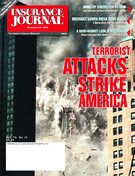The business of reinsurance is a comparatively small but integral part of the overall insurance industry. Simply defined, reinsurance is transacted on the basis of one insurance company, the “reinsurer,” agreeing to indemnify another insurance company, the “reinsured,” for all or part of the insurance risks underwritten by the reinsured.
Since the reinsurance transaction takes place entirely between insurance organizations, with very little regulatory control on pricing and agreement documentation, the insurance-buying public is not aware of its existence.
The recent tragic and catastrophic loss at New York’s World Trade Center is bringing in initial estimates of insured loss at $25 billion, and property damage alone could reach $10 billion.
The corporate insurance buyers in the World Trade Center responsible for purchasing many millions of dollars of insurance coverage have by necessity become exposed to the intricacies of the types of reinsurance, treaty reinsurance and facultative reinsurance; as well as the two forms of reinsurance methods, pro-rata and excess of loss.
The primary insurers providing direct insurance coverage for specific insureds in the World Trade Center gross up their capacity to a single amount of coverage that the policyholder sees, but behind that gross amount can be automatic or treaty reinsurance capacity for one limit, as well as facultative reinsurance capacity on an excess of loss basis for another limit.
To illustrate, let’s look at a hypothetical primary insurance policy for property coverage whereby the insurance company provided $25 million of property coverage. That same company could have turned around and ceded for the first $10 million of loss to its treaty reinsurers. The first treaty reinsurer, a direct writer, writes a treaty for 100 percent of $4 million in excess of $1 million. The second group of treaty reinsurers, and there are five of them, write $1 million part of $5 million, in excess of $5 million in their property excess of loss treaty.
To recap, the first $10 million of loss on the $25 million gross policy is going to be shared by a primary insurer and six treaty reinsurers.
To continue the illustration on the World Trade Center loss, the next $15 million on the $25 million policy has the primary insurer purchasing property facultative reinsurance, which can be arranged in increments of $5 million, so that facultative reinsurance certificates would look like $5 million P/O $15 million in excess of $10 million any one property loss.
What is the initial outcome of all this? The primary insurer can say they had a $25-million gross loss in the World Trade Center catastrophe, but after reinsurance, it was $1 million.
Keeping with this same illustration, the reinsurer that provided the first $4 million in excess of $1 million, in turn purchased retrocessional protection behind the $4 million from the London reinsurance market and the European reinsurance market. Even the reinsurance industry needs protection, and reinsurers buy it in the form of retrocessions, which provide them with reinsurance capacity. The retrocession protection can also be purchased on an excess of loss basis, or a pro-rata basis, meaning the $4 milion that the reinsurer provided to the insurer was reinsured by the reinsurer, in a completely unregulated environment as to reinsurance rate and coverage. The collection of reinsurance receivables, because of the magnitude of the primary insured loss, will also become a significant complex task. Each primary insurer has to collect from its reinsurer, and the reinsurers have to collect from their retrocessionaires.
Other significant reinsurance issues include defining an “act of war.” Also, does the engineering reports show the potential collapse of the Towers; what about treaty reinsurance exclusions? What about the target risk clause in the treaty reinsurance agreements? What about the larger reinsurers who write the treaty reinsurance agreements for a significant number of insurers who write primary insurance on the World Trade Center? How many insurers and reinsurers will participate in this catastrophic event?
Once more, the insurance and reinsurance industry will be tested, and always in a time of devastation and loss of life of catastrophic proportions. Let’s hope there are no hurricanes or earthquakes— the real acts of God that test the financial resources of insurers and reinsurers—in the remainder of 2001. In my 40 years in the industry, I would never have imagined the collapse of both towers of the World Trade Center.
Topics Carriers Profit Loss Excess Surplus Reinsurance Property Market
Was this article valuable?
Here are more articles you may enjoy.


 FBI Involved After Two Florida Injury Lawyers Go Missing From Fishing Trip
FBI Involved After Two Florida Injury Lawyers Go Missing From Fishing Trip  AIG’s Zaffino to Step Down as CEO as Aon’s Andersen Steps In
AIG’s Zaffino to Step Down as CEO as Aon’s Andersen Steps In  Cloudy Future for Bourbon Has Jim Beam Closing Distillery for a Year
Cloudy Future for Bourbon Has Jim Beam Closing Distillery for a Year  Kansas Man Sentenced to Probation for Insurance Fraud
Kansas Man Sentenced to Probation for Insurance Fraud 


